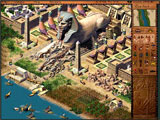 The history and culture of ancient Egypt
continues to fascinate man to this very day. No
other civilization in history has left such lasting marks of its history as the ancient
Egyptians did. From the pyramids to the
sphinx to the hieroglyphs that cover their ornate tombs, the culture of ancient Egypt
lives on, evoking wonder and awe to all who study it.
With Pharaoh, Impressions allows players to design and build a complete Egyptian
city, complete with monuments, temples and industries, and provides a challenging gaming
experience in the process. The history and culture of ancient Egypt
continues to fascinate man to this very day. No
other civilization in history has left such lasting marks of its history as the ancient
Egyptians did. From the pyramids to the
sphinx to the hieroglyphs that cover their ornate tombs, the culture of ancient Egypt
lives on, evoking wonder and awe to all who study it.
With Pharaoh, Impressions allows players to design and build a complete Egyptian
city, complete with monuments, temples and industries, and provides a challenging gaming
experience in the process.
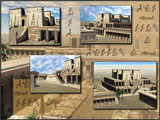 Based heavily on the Caesar 3 game, Pharaoh places the player in
the role of a staunch supporter of the future pharaoh of Egypt. To help accomplish his dream of uniting Egypt
under his rule, this visionary has charged you to build and rule several cities, each
devoted to the greater glory of Egypt. The
game flows as a series of missions, beginning with the pre-dynastic period and progressing
through the 20th dynasty, which covers nearly the whole history of ancient
Egypt. This sweep of history is divided into
five ages, each of which consists of several different missions. In each mission, players must build up a city from
nothing, molding it into a thriving center of industry, culture and trade. Each mission has a different focus; some require
heavy industry and trade, while others require a more militant approach. As time progresses, new technological developments
become available, such as irrigation and temple complexes.
This variation keeps the game interesting and challenging without seeming
repetitive. Based heavily on the Caesar 3 game, Pharaoh places the player in
the role of a staunch supporter of the future pharaoh of Egypt. To help accomplish his dream of uniting Egypt
under his rule, this visionary has charged you to build and rule several cities, each
devoted to the greater glory of Egypt. The
game flows as a series of missions, beginning with the pre-dynastic period and progressing
through the 20th dynasty, which covers nearly the whole history of ancient
Egypt. This sweep of history is divided into
five ages, each of which consists of several different missions. In each mission, players must build up a city from
nothing, molding it into a thriving center of industry, culture and trade. Each mission has a different focus; some require
heavy industry and trade, while others require a more militant approach. As time progresses, new technological developments
become available, such as irrigation and temple complexes.
This variation keeps the game interesting and challenging without seeming
repetitive.
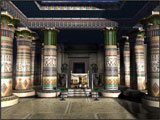 Pharaoh provides the aspiring city builder with many tools to
accomplish his goal of building a great, thriving city.
Placing housing attracts immigrants, who become the lifeblood of the city. To keep them healthy and happy, the ruler must
provide food, employment, culture and diversion. Food
comes from a variety of sources, including farms, wild game, and trade, and is stored in
granaries and distributed by bazaars. Citizens
want jobs, too, but are willing to perform a wide range of tasks. Fire marshals, policemen and architects keep your
city safe and stable, while physicians, alchemists and dentists keep the people healthy. There are dozens of industries that can be built,
and each provides a useful service or product that can be traded or used by citizens to
advance their social standing. Citizens
also like government, and a palace is seen as the center of city government. They also want courthouses to resolve disputes,
and don’t mind paying taxes as long as everyone is taxed equally and fairly, which
helps provide the city with income to pay workers and erect new structures. Pharaoh provides the aspiring city builder with many tools to
accomplish his goal of building a great, thriving city.
Placing housing attracts immigrants, who become the lifeblood of the city. To keep them healthy and happy, the ruler must
provide food, employment, culture and diversion. Food
comes from a variety of sources, including farms, wild game, and trade, and is stored in
granaries and distributed by bazaars. Citizens
want jobs, too, but are willing to perform a wide range of tasks. Fire marshals, policemen and architects keep your
city safe and stable, while physicians, alchemists and dentists keep the people healthy. There are dozens of industries that can be built,
and each provides a useful service or product that can be traded or used by citizens to
advance their social standing. Citizens
also like government, and a palace is seen as the center of city government. They also want courthouses to resolve disputes,
and don’t mind paying taxes as long as everyone is taxed equally and fairly, which
helps provide the city with income to pay workers and erect new structures.
Religion and culture play a big part
in an Egyptian’s life. Citizens like to
be entertained, so rulers must provide booths, bandstands and pavilions where jugglers,
dancers and musicians can perform. Citizens
also need temples where they can worship the Egyptian gods.
The gods play an important role in Egyptian society, and can directly affect
the prosperity of a city. Happy gods bestow
blessings such as fertile crops and healthy citizens, or they can smite a city with
plague, fire or famine. In each city, a
single god will be the patron deity, demanding more worship. In later missions, a temple complex can be built,
and is a great center of worship, raising the city’s culture and appeasing the patron
god. Rulers would do well to appease the
gods, lest their cities wither and die from the wrath of the gods.
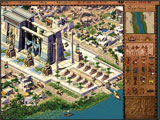 When ancient Egypt is mentioned, the first things most people
think of are the pyramids and the sphinx. Pharaoh
doesn’t disappoint here, allowing rulers to construct these great monuments for the
greater glory of Egypt and its people. From
the smallest mastaba to the great pyramids, building these structures is truly a
monumental task, and will require tremendous resources from your city. Laborers will work for years digging and laying
block, supported by brickworks, mines and craftsmen.
The construction of one of these great monuments is a great accomplishment, and
will raise a ruler’s status throughout all of Egypt. When ancient Egypt is mentioned, the first things most people
think of are the pyramids and the sphinx. Pharaoh
doesn’t disappoint here, allowing rulers to construct these great monuments for the
greater glory of Egypt and its people. From
the smallest mastaba to the great pyramids, building these structures is truly a
monumental task, and will require tremendous resources from your city. Laborers will work for years digging and laying
block, supported by brickworks, mines and craftsmen.
The construction of one of these great monuments is a great accomplishment, and
will raise a ruler’s status throughout all of Egypt.
As if the daily management of a city
isn’t enough, rulers will sometimes have to worry about defending their city from
foreign invaders. Enemies can come from land
or sea, so rulers must build shipwrights to construct warships and transports, and place
forts to house companies of infantry and bowmen who will defend the city from enemy
soldiers. Infantry require weapons, so if a
weaponsmith is not available they will have to be imported from other cities. A well-trained military can keep a city from being
razed and looted by unfriendly neighbors. Companies
can be given different formations and orders, such as hold ground or seek and destroy. Unlike in Caesar 3, units in Pharaoh will
actually engage and attack nearby enemies, rather than just stand idly by while policemen
defend the city against invaders.
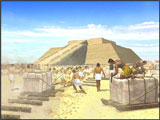 Graphically, Pharaoh is beautiful.
Terrain features are detailed and easy to identify and distinguish from one
another. Citizens and industries are
similarly detailed, with individual animations that show the type of work being done, from
digging gold in a mine to making papyrus. Soldiers
march into combat, firing arrows and swing swords, while ships sail through the water,
carrying trade goods or firing at enemy craft. Wild
game move in herds, stalked by hunters who carry them back to the city for storage. If a worker ventures too close to a crocodile,
the crock will dispatch him, leaving a corpse. One
of the most fascinating procedures is the process of building a pyramid, where workers
level the site, dig down to bedrock, cut a grid of fissures in the rock and fill them with
water. Then, they drain the water, chisel off
the stone to the waterline, and fill the base with aggregate, which is compacted. Finally, the blocks of the pyramid are laid. Right-clicking on the pyramid site brings a
description of the current stage. Graphically, Pharaoh is beautiful.
Terrain features are detailed and easy to identify and distinguish from one
another. Citizens and industries are
similarly detailed, with individual animations that show the type of work being done, from
digging gold in a mine to making papyrus. Soldiers
march into combat, firing arrows and swing swords, while ships sail through the water,
carrying trade goods or firing at enemy craft. Wild
game move in herds, stalked by hunters who carry them back to the city for storage. If a worker ventures too close to a crocodile,
the crock will dispatch him, leaving a corpse. One
of the most fascinating procedures is the process of building a pyramid, where workers
level the site, dig down to bedrock, cut a grid of fissures in the rock and fill them with
water. Then, they drain the water, chisel off
the stone to the waterline, and fill the base with aggregate, which is compacted. Finally, the blocks of the pyramid are laid. Right-clicking on the pyramid site brings a
description of the current stage.
The manual is rather thick, and does
a good job of describing each game element. There
is a running diary of a visitor to an Egyptian city, describing what everyday life was
like in that era. One of the most
interesting elements is the brief history of Egypt, from the pre-dynastic period through
the fall of the 20th dynasty, which highlights the major events of each era. There are also small sidebars that describe
elements of Egypt and its people, such as the annual flooding of the Nile River, known as
the lifeline of Egypt. Audio is also well
done, with appropriate, realistic sound effects and music that has a distinct Egyptian
flavor but doesn’t overwhelm gameplay.
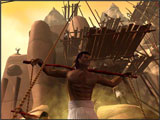 There are two main problems with Pharaoh that crop up during play,
though both are relatively minor. As the city
grows, the elements of management begin to add up, and can bog down play. Managing all the city elements, including
industry, religion, military and municipal elements, becomes more and more difficult as
the city grows. There is a speed control that
can compensate for this, but lowering the speed slows down gameplay even further. Once a good balance is achieved, however, the city
can basically run itself, freeing players to concentrate on expansion and other areas of
management. The other main problem, and one
that does slow down gameplay, is the sheer amount of time it takes to build the larger
monuments can make for some long missions. The
monuments can’t be started until there is sufficient industry and labor to support
it, and the process takes a great deal of time to complete.
Though the process is historically accurate, game flow suffers a bit, but, in this
case, realism wins out. There are two main problems with Pharaoh that crop up during play,
though both are relatively minor. As the city
grows, the elements of management begin to add up, and can bog down play. Managing all the city elements, including
industry, religion, military and municipal elements, becomes more and more difficult as
the city grows. There is a speed control that
can compensate for this, but lowering the speed slows down gameplay even further. Once a good balance is achieved, however, the city
can basically run itself, freeing players to concentrate on expansion and other areas of
management. The other main problem, and one
that does slow down gameplay, is the sheer amount of time it takes to build the larger
monuments can make for some long missions. The
monuments can’t be started until there is sufficient industry and labor to support
it, and the process takes a great deal of time to complete.
Though the process is historically accurate, game flow suffers a bit, but, in this
case, realism wins out.
Overall, Pharaoh is a great game that
provides an in-depth look at life in ancient Egypt while providing many hours of
engrossing gameplay. Players who enjoy
building and managing cities, strategy gamers, and anyone who would like to learn more
about Egyptian culture, as well as anyone who enjoyed the Caesar games, should give
Pharaoh a try. They won’t be
disappointed.
--Derek Meyer |
